Revista Electrónica de Investigación Educativa
Vol. 8, No. 1, 2006
Motivations, Learning, Approaches, and Strategies
in Biochemistry Students at a Public
University in Argentina
Silvia Raquel Salim
salimraquel@gmail.com
Instituto de Microbiología
Facultad de Bioquímica, Química y Farmacia
Universidad Nacional de Tucumán
Ayacucho 491 - (4000)
San Miguel de Tucumán, Argentina
(Received: July 4, 2005;
accepted for publishing: March 17, 2006)
Abstract
The aim of the present paper is to understand how university students learn, and to comprehend the motivations and learning strategies they use when deciding in what field to major. We chose a combined research design: qualitative and quantitative. We applied the Questionnaire for the Evaluation of Learning and Studying Processes (CEPEA) to Biochemistry students attending the National University of Tucumán (Argentina), and performed individual semi-structured interviews. Cluster analysis allowed us to identify three groups of students having who use different learning approaches: deep, superficial and ambivalent. We found that learning approaches are closely related with some teaching practices that encourage or inhibit them; among these are the types of learning evaluation.
Key words: Student motivation, educational strategies, learning approaches.
Introduction
Today, the study of learning is based on the perspective of the student, who is the one giving meaning and sense to the materials he is processing, and the one who decides what he has to learn, as well as how to do it. During the last twenty years there has been a growing interest in the student’s ongoing analysis and involvement when learning. A consideration of students’ prominent role, together with their share of responsibility in learning and in the interpretation of the situations they experience, has generated in the university, fruitful lines of research concerning learning processes and the cognitive and motivational determinants thereof.
Without a doubt, the way to find out how the student learns is to go to him and ask him how he does it. The key is to see what kinds of motives and strategies he develops to achieve his concrete learning goals or objectives.
It seems to be accepted that learning requires the availability and use of precise strategies. This availability necessarily involves motivation (or more specifically, a set of variables such as learning goals and self-concept); it also involves the learning concept the student maintains, as well as how he addresses it (learning approaches).
These interrelated issues are the subject addressed in this investigation: the motivations, the kinds of approaches and the learning strategies used by students majoring in Biochemistry; and how these pupils relate such issues to their learning activities. Based on the foregoing, we propose to show a profile of the selected population in relation to their expectations for success.
The differences in how students approach learning situations has led to the emergence of a research current developed in a number of universities in various parts of the world regarding the study of learning approaches,. These studies have had great resonance in the field of educational research because of the relationship they establish between strategic and motivational aspects of learning.
There was observed a remarkable consistency in the identification of two types of learning approaches: superficial (orientation toward reproduction) and deep (orientation toward understanding the meaning). Svensson in 1977 showed that students who adopt a deep style spend more time in studying, and consider the material they learn to be easier to understand than students who adopt a surface style. The second type of learners, by focusing on strategies of memorization and retention, find the work heavy and thankless, and tend to fail tests more often.
Some authors concur in associating a type of motivation with each of the learning approaches (Biggs 1985, 1989, 1991, Entwistle, 1988a; Schmeck 1988; Weinstein, Goetz and Alexander 1988). These authors have found that there is a certain relationship between the type of motivation and the learning approaches demonstrated by students facing a particular learning task. Thus, the predominant type of motivation in the individual may be significantly related to the use of certain learning strategies, and consequently, to the approach the student uses.
Learning approaches based on motivational-strategic relationships can be described as follows: those students who aim to meet the minimum requirements of the task, with minimal effort and involvement in it, will launch certain strategies by which to learn information mechanically and repetitively, and will reproduce the information at the right time. These motivational-strategic relationships reflect the characteristics of the surface approach. On the other hand, those students with high intrinsic interest and a high degree of involvement in what they are learning, and who have the goal of understanding significantly, develop strategies for discovering the meaning of what they learn, building relationships with relevant background knowledge. These motivational-strategic relationships reflect the characteristics of the deep focus (Valle, González Cabanach and Vieira, 1997).
But apart from the two approaches mentioned, there has been identified a third approach called the achievement approach (Biggs 1988, Entwistle 1988b), which involves a clearly-defined aim: to obtain the best performance possible, through proper planning of activities, effort and available time. In other words, this approach is characterized by planning and organizing various activities with the primary objective of getting the highest possible grade (Valle, Barca, Gonzalez Cabanach, Porto and Santorum, 1993).
One can see the deep and surface approaches as mutually exclusive to some extent; the achievement approach, however, can be linked to a either a deep or a surface approach, depending on the particular learning context. Students who believe that the best way to get high grades is to learn the material mechanically and repetitively without having to understand the meaning of it, may possibly combine the surface and achievement approaches. In contrast, students who believe that getting high scores depends on understanding and establishing relationships between the new learning and prior knowledge, may adopt a combination of the deep and the achievement approaches. Such a combination of approaches gives rise to compound approaches: surface-achievement and deep-achievement.
Methodology
Because of the nature of our research question, we chose a combined quantitative and qualitative methodology: we used a standardized questionnaire that could be applied collectively, and conducted in-depth interviews. Our decision was based on the fact that the use of both instruments could help to control and correct the biases inherent in each method.
While the questionnaire assesses the degree and level of the learning approaches a university student adopts in her study process, along with the motives and strategies that compose these approaches to learning, the interview provides an understanding of students’ personal vision concerning their learning, their difficulties and their performance. We have considered it relevant to conduct both quantitative and a qualitative research.
a) Population
This consisted of 248 university Biochemistry students at the National University de Tucuman (Argentina), both sexes, age 20 - 27 years. Of these, 86 students (34.7%) were in their second year of studies (basic stage); 67 (27.0%) in their 4th year (intermediate stage), and 95 (38.3%) in their 5th year (professional stage). Based on the criteria of students’ academic performance, listed below, a total of 20 in-depth interviews were performed.
b) Sample
Since we were using an observational methodology that does not propose a causal explanation, but seeks to understand the meanings students ascribe to learning, for the quantitative determinations we worked with a non-random sample made up of volunteer students.
The population selection for the qualitative determinations was made using a purposive sampling of students based on the following criteria for academic performance: academically successful students (have an average grade of 7 or more, and who finish their studies in the time established in the curriculum);1 those who fail repeatedly; and those who lag behind (are delayed in their studies with regard to the average duration of the degree program.)
c) Questionnaire
We used the Alfonso Barca Lozano (1999) Questionnaire for the Evaluation of Learning and Study Processes (CEPEA) for university students, adapted for Spanish students as based on the Biggs SBQ questionnaire (1970), designed to assess learning approaches in Australian students. The questionnaire is completed using a Likert scale (1-5), and consists of 42 items that permit the acquisition of scores for six subscales: three for motives and three for learning strategies (surface, deep and achievement); and scores for three scales of approaches and two composite approaches (surface-achievement and deep-achievement). The questionnaire is individual in application, and the application time is variable (15-20 minutes).
The quantitative analysis consisted in processing the sample and calculating the measurements according to the criteria provided by the instrument. Three profiles were obtained as a result: 1) surface (S), made up of two subscales: motives and surface strategies that represent the approach S; 2) deep (D), made up of the two subscales D, and 3) a profile we called ambivalent (A), in which no significant differences were observed either in the values of the subscales or of the scales. To perform these operations there was applied a custom-made program2 that automatically corrects the original numerical scale and makes the graph for the profiles (see Figures 1, 2 and 3).
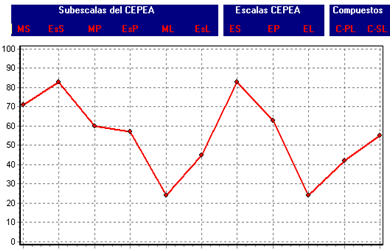
Figure 1. Surface profile
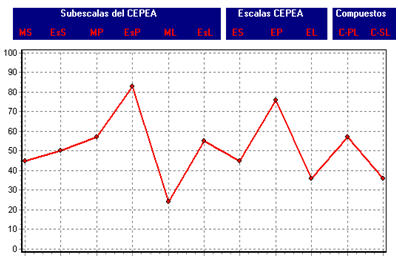
Figure 2. Deep profile
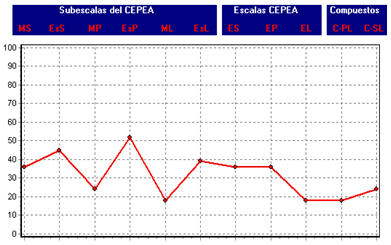
Figure 3. Ambivalent profile
The classification of groups, as homogeneous as possible, was done using multivariate cluster analysis, which aims to search for similar groups of individuals gathered into clusters.
d) In-depth interview
The questions were prepared for understanding the motivational and cognitive characteristics of the group of students who voluntarily participated in the interviews. Each interview, oral and individual, pre-planned, had a variable duration of from 60 to 90 minutes. Both verbal and nonverbal communication was recorded. The contents of each interview was recorded and transcribed in text form.
The interview had two parts, one on the student’s personal data (age, origin, high school diploma, parents’ level of education, major, course, year of entrance, and occupation [if any]); the other related to her learning concepts, her motives for studying, and the learning strategies she uses.
The section of the interview connected with motivation consisted of questions asked about motivational aspects: personal perspectives (reasons for choosing the major, aspirations and expectations regarding the degree, chances of success, emotions, academic goals, her experiences and perceptions concerning her study activities in particular and campus life in general. She was questioned about the context (school, curriculum, teachers and infrastructure).
The section concerning the use of learning strategies consisted of questions directed toward finding out how she uses production strategies, organization, review, metacognitive self-control, time management, management of effort, learning with peers, seeking help, etc.
The information gathered through interviews was studied through analysis of qualitative content. A first type of information processing consists of the reduction of the data, i.e., the simplification and selection of information. For that, we have coded and categorized the qualitative data, which means that out of a large and complex set of information we were able to extract more manageable elements which would allow us to establish and draw conclusions.
To do this we have adapted the phases that make up the process of theorizing described by Tesch (1989): discovery of the units of analysis, categorization or conceptualization, hypotheses or proposals, and formulation of the theory.
The information gathered was studied using the program NUD*IST (Non-Numerical Unstructured Data Indexing Search and Theorizing), which permits the coding and categorizing of data. This is used to build a hierarchical structure allowing the organization of the categories in the form of an inverted tree. Each category branches off into sub-categories of analysis which, in turn, are divided into subsidiary branches.
The hierarchical tree allows the linking of categories among themselves and their subcategories. This construction permits the establishment of categories emerging from the field, and permits an objectivization of students’ voices, thus reducing the subjectivity of field work. The hierarchical tree we obtained let us classify different categories of content, group them, and establish relationships between categories, concepts and themes in an organized and flexible manner.
Using the data, in the course of the study we built two concept structures hierarchized in the form of an inverted tree, whose roots were made up of: the motivations and the learning strategies. Each of these two category indices is subdivided into other categories, and these in turn are divided into subcategories, as shown in Table I. Similarly, each of the categories contains “daughter” subcategories, from which subsidiary branches also emerge.
Table I. Concept structures
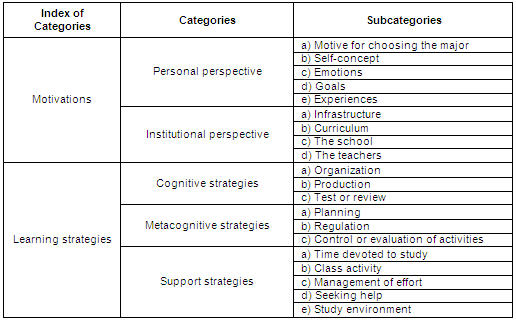
In the course of the process we created categories based on the data (patterns of meaning found in the entire volume of information), based on the previous ideas (preexisting theoretical developments) and our own knowledge of the context.
With the development of the category system, what we were trying to do was reconstruct a sort of conceptual scaffolding to provide us with support and coverage for all the data collected in interviews. The NUD*IST program provides a range of options for organizing the categories in a tree of categories, with subcategories, making it possible to clarify concepts, find the categories, and see the relationships between them and their subcategories.
The NUD*IST program also allowed us to exchange information between the categories and to establish comparisons with the three groups of students according to their type of learning approach (surface, deep and ambivalent).
e) Validation
To validate the results from both sources (questionnaire and interviews) there was chosen theoretical and methodological triangulation in which the results of the questionnaires and interviews were crossed-referenced among themselves and with theoretical data (results of other studies). The triangulation of methods allowed the analysis of convergences and divergences between quantitative and qualitative data, and prevented or corrected the biases that can occur when the observations are performed by a single investigator.
Results
Cluster analysis identified three groups of students who presented major differences in learning approaches: deep (56.0%), surface (22.6%), and ambivalent (21.4%).
The motivational profile of the group of participating students (Figure 4) shows a predominance of Category 1 (surface) in the S group; there are significant differences between Categories S and D in Group 2 (deep); the measurements are low in group 3 (ambivalent), with predominance of the S component; and the resolution in the measurement of motivations is low.
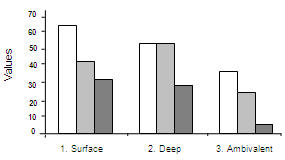
Figure 4. Motivations
In the general assessment of students’ use of strategies (see Figure 5) there can be clearly distinguished Groups 1 (S) and 2 (D) with an important resolution and statistical differences clearly significant. This would show a certain success for the instrument in measuring this variable. In Group 3 (ambivalent) there is observed quite a high component of deep strategy.
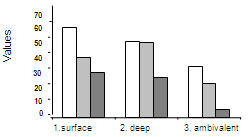
Figure 5. Strategies
Figure 6 shows that students show significant differences in the approaches they use. There are two groups clearly dissimilar in their approaches: S and D. The third group—which we call ambivalent—does not match them; it does not conspicuously adopt either of the two approaches identified by the instrument.
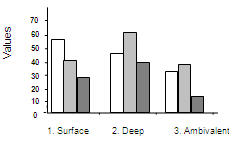
Figure 6. Approaches
In Figure 7, Group 2 is visibly defined in terms of a high and significant measurement of the category deep (48.8 for cluster 2). However, it is not possible to differentiate between Groups 1 and 2 depending on the measurement of the surface category (43.98 for Cluster 1 vs. 42.2 for Cluster 2). This may be due to the generally-low measurements for the category achievement provided by the instrument.
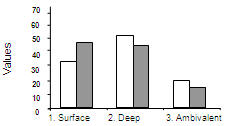
Figure 7. Compound
We found that the resolution in the measurement of motivation is low. Measurements of strategies have higher indices than the motivational.
Students of the ambivalent group show academic achievement levels significantly higher than students with the D approach. They are perhaps conditioned by the opposing effects of the motivational components: achievement and fear of failure.
Conceptual differences are identified in four items of the surface motivation and of achievement. What is achievement motivation for the authors of the CEPEA, for our idiosyncrasy is for surface motivation, and vice versa. We would then be detecting cultural differences, since the CEPEA questionnaire is an instrument designed to evaluate learning approaches in Australian university students, and is experimentally adapted to Spanish students.
There is a lack of correlation between D-approach students and their grades. They do not conspicuously present higher academic performance levels. Students who adopt a deep approach do not necessarily generate good academic results and vice versa. Paradoxically, the achievement levels of these students are not higher than those of the rest of the groups.
Successful students, those who fail repeatedly, and the ones who lag behind, are found in all three groups (surface, deep and ambivalent). In turn, students with the highest average grades are located in the ambivalent group. It is possible that the latter are conditioned by the opposing effects of the two motivational components: achievement motive and fear of failure.
The student chooses one way or another to process information, although it is possible to distinguish a particular evolutionary direction: as it advances in the study program, the population adopting a deep approach grows. This would indicate a transition from learning style S to style D, which could be explained as an attempt to adjust to the demands perceived, and as an improvement in their learning strategies. And this, in turn, could evince a process of further adaptation to the university environment (learning the “job” of a being a college student and adjusting so as to follow the rules better). When the student understands the task better, he uses strategies that involve in-depth study.
The composition of the population surveyed is as follows: 5% surface-failed, 10% surface-successful, 10% superficial-lagging, 5% deep-lagging, 20% deep-successful, 35% deep-lagging, 10% uncertain-successful and 5% uncertain-lagging.
The analysis of the motivations that lead students to choose the Biochemistry major shows that they usually pick it “because they have a taste for it, “because they like it”, “because it’s interesting”, without specifying their reasons, or a prior reflexive analysis of their personal characteristics and of the social reality that leads them to choose it. It can be inferred that family members, teachers and/or professional acquaintances had an influence. Students did not know aspects of the major, the work field or the social demands (“All I knew was that [biochemists] did blood tests”).
Only two students chose to major in studies they had begun in high school. Their intent was to get a degree and social recognition (“to be somebody”). The degree means self-improvement, job opportunities, achievement (“A degree is a doorway to better opportunities.”) Only two students were identified with the desire to learn, to know more.
Generally speaking, we can say that our students tend to enter university with the intention of getting a degree. They choose the major because they want to be independent and to have a job with some prestige. Their choice does not allow us to assume that they have a taste for work or for the subjects; confidence in their abilities; or the perseverance needed for the academic work.
The negligible advantage they take of their high school studies predicts a poor preparation for entering the university. They concentrate on personal achievement, and are concerned about getting the degree and getting a job. Their motivations are more extrinsic than intrinsic, and this disparity between what students do and what they say could indicate that, despite the D profile, the academic environment would strongly determine that their performance be conceived more in terms of achievement (passing) than learning.
They perceive the program of studies as a road, a chance for self-improvement. We can define them as individuals with a specific purpose of self-realization and personal improvement. This evidence would lead one, at first glance, to make a judgment of the type: “Students are shallow.” In a closer reading, the evidence can be interpreted as a deficiency on the part of institutions in promoting deep motivations. Only 10% of the students identify themselves with the desire to learn, to learn more. This desire would involve, on the part of the institution, the need to reinforce the culture of education, significant learning, and personal development for professional training, and thus, the discouragement of academic practices leading to a simple compliance with requirements so as to pass subjects and thus reach their goal.
Four practices appear to be decisive in achieving academic success: studying, spending time, putting forth effort, and perseverance. Success depends almost exclusively on the student. He feels responsible for his satisfactory performance. Apparently significance is not assigned to the learner’s ability or intelligence (motivation S). Little importance is attached to his life situations (work, socioeconomic, marital, etc.) These references allow us to conclude that students attribute the successful outcome of their performance to stable, controllable and internal factors (effort, dedication, perseverance, will), which would coincide with a profile of achievement. At the same time, the silence concerning the role of intelligence, and that of physical living conditions and motivations would confirm their surface motivations.
The other side of the coin seems to show that academic failure does not depend almost exclusively on the student; also responsible for it are “poor foundation in high school,” “inability to adapt,” “injustice,” “fear, nerves” and the teacher himself.
It is assumed that emotions play an important part in the student’s psychological life, and have a strong influence on academic motivation and on cognitive strategies—and therefore, on learning and school performance. Generally, students enjoy performing the task when they understand and find meaning in what is being taught (“I like it, I feel enthusiastic about it.”)
They have as many hopes for passing as for the evaluation of their effort and dedication. The personal goals our students are most concerned with or are interested in, are related to emotional issues and achievement: having a family, getting their degree, getting a job, and to a lesser degree, continuing their studies so as to specialize in something.
In relation to their experiences and perceptions, students have generalized problems: they have little knowledge about what the university really is; they have strong feelings about loneliness, helplessness and the lack of friends. They also have difficulty in understanding the explanations, and they face problems in adjusting to the academic demands.
On the other hand, students consider that the conditions of infrastructure are critical; these offer the student no encouragement, but rather, reinforce the perception of the redoubled effort that must be made so as to learn under extremely precarious conditions.
Such findings lead us to the conclusion that students enter a world unknown, hostile and fraught with difficulties. Their adaptation to new ways of learning, of socializing, and of living is an abrupt change that has major effects on learning. The academic environment provides no motivational incentive, and influences them to regard what they are doing more in terms of achievement (passing), than in terms of learning (relation between the didactic context and the strategy of the student).
The student is not only linked with peers and teachers, but also relates with the degree program and the institution. Students perceive the curriculum as a set of subjects, teachers, examinations and study materials; they find it “overwhelming”, “stressful”, “tiring”, with an excessive academic load and virtually non-existent free time. We think that the pressure leads the student to see many issues in a short time, and she doubts whether she is really learning. (Does this promote the use of the S approach?). Possibly in the reformation of the curriculum there was applied the logic of accumulation rather than that of selection and sequencing appropriate to the time available.
Teachers influence what students want to know and what they think. (“Maybe I would have liked the subject, but the teacher made me not like it”). The messages the teacher transmits are often associated with motivational changes (“If the teacher says this is important, then I make a little mark.”)
The student must learn to adapt to the attitudes, preferences and prohibitions of the teacher. (“First I talk with the kids who have already taken the class, so as to know what I am facing.”) Thus, we can say that students learn ways to act: to manage with security, to know when to shut up, interpret what is being asked, and to answer “what the teacher wants to hear.” On the exam, students are asked for an exposition of a topic. (“When I study I don’t think about what they might ask me; I think about an exposition”). So, does this promote the development of S approaches?
In their study process, students set in motion a series of learning strategies: reading, re-reading, underlining, summarizing, etc., and everybody prepares to study. Almost all are neat and organized (process D). Less than half set up their plan so as to improve time management. S-group students use only reading, but those in groups D and A use more than one active strategies (underlining, concept maps, summarizing and other complex techniques) and reflect on how to use them. Everyone tries to understand and retain information. Half of the students learn by heart “as a requirement of the kind of knowledge or of the subject.” They all practice or review to check how much they remember. The taste for the subject has a positive effect on the motivation for study. (“The ones I don’t like, I study just any old way... “) The time devoted to study depends on the subject (“The one I like, I fly through”), and on the characteristics of those who evaluate them.
They choose and carry out activities to help them pass and move ahead in the program, rather than because of their interest. They differentiate between exams that consist of “repeating information” and “the ones that make you have to think.”
Based on these findings we can conclude that we have not encountered students with a restrictive S approach (memorization as a single objective). We found a close relationship between students’ type of strategies and their motives and goals. Generally speaking, they are more motivated to avoid failure than to learn. On the examination there is usually required the exposition of a subject, but this is not satisfactorily directed toward the development of cognitive strategies for meaningful learning.
The evaluation and accreditation of knowledge determines the approach to learning. Students adjust their approach to comply with the demands (strategic adaptability). They intend to understand (D approach), but the examination favors changing over to an approach that will help them pass (S).
Conclusions
In general, it can be said that the results of this study confirm the hypotheses and conclusions of many authors mentioned throughout this work, regarding:
- the existence of an association between motivation and strategy use;
- the importance of students’ involvement in their own learning process; and
- the influence of context in determining approaches to learning.
Along with these verifications, this study contributes new insights to the complex set of variables that affect learning processes in a school of science, as well as a better understanding of the role of a university student—a subject almost unknown in the university in the field of management and academic development.
In this regard, let us call attention to these points:
- The approaches are related to practices that promote or inhibit them.
- Evaluation focused on the final result does not assess the strategies used by the student. Thus, students with high levels of learning strategies and motivation fail in this type of evaluative practice.
- The current evaluation procedures encourage in the student the strategic adjustment of her approach. It is probable that these procedures would achieve an effect contrary to the objectives of university education: studying in order to pass, instead of studying so as to know or learn.
It is to be hoped that an intervention directed toward modifying the evaluation procedures would have effects on learning approaches as well on the modification of teaching strategies and approaches.
Perhaps we would do well to give a careful look at the students’ daily realities; these reflect problems far more important than the bureaucratic and formal questions. At the end of the day, any university activity is meaningless if it is not directed primarily toward training all the institution’s students better, and with greater success.
References
Barca, A. (1999). Manual del Cuestionario de Procesos de Estudio y Aprendizaje (cepea). Revista Galego-Portuguesa de Psicoloxía e Education.
Biggs, J. B. (1970). Faculty patterns in study behaviour. Australian Journal of Psychology, 22 (2), 161-174.
Biggs, J. B. (1985). The role of metalearning in study process. British Journal of Educational Psychology, 55, 185-212.
Biggs, J. B. (1988). Assessing study approaches to learning. Australian Psychologist. 23,197-206.
Biggs, J. B. (1989). Approaches to the enhancement of tertiary teaching. Higher Education Research and Development, 8 (1), 7-25.
Biggs, J. B. (1991). Approaches to learning in secondary and tertiary students in Hong Kong: some comparative studies. Educational Research Journal, 6, 27-39.
Entwistle, N. J. (1988a). La comprensión del aprendizaje en el aula (Trans. I. Menéndez). Barcelona: Paidós-Ministerio de Education y Ciencia (Original work published 1988).
Entwistle, N. J. (1988b). Motivational factors in student’s approaches to learning. In R. R. Schmeck (Ed.), learning strategies and learning styles (pp. 68-93). New York: Plenum Press.
Schmeck, R. R. (1988). Learning strategies and learning styles. New York: Plenum Press.
Svensson, L. (1977). On qualitative differences in learning. III. Study skill and learning. British Journal of Ed. Psychology, 47, 233-243.
Tesch, R. (1990). Qualitative research: Análisis types and software tools. New York: Falmer.
Valle, A., Barca, A., González Cabanach, R., Porto, A., & Santorum, R. (1993). Aprendizaje significativo y enfoques de aprendizaje: El papel del alumno en el proceso de construction de conocimientos. Revista de Ciencias de la Educación, 156, 481-502.
Valle, A., González Cabanach, R., & Vieiro, P. (1997). Características Diferenciales de los enfoques de Aprendizaje en estudiantes universitarios. Revista de Psicodidáctica, 4, 25-37.
Weinstein, C. E., Goetz, E. T., & Alexander, P. (1988). Learning and study strategies: issues in assessment instruction and evaluation. New York: Academic Press.
Translator: Lessie Evona York Weatherman
UABC Mexicali
1In the National University of Tucuman, the grading scale goes from 0 to 10, where 0, 1, 2 and 3s = failed, 4 and 5 = regular, 6 and 7 = good, 8 = very good, 9 = distinguished, 10 = excellent.
2This program lets you enter data, process them and translate them into graphics. It was developed by Dr. Alfonso Barca-Lozano, Virtual Psychology Center, S. L. (Argentina), who is also the author of the CEPEA Scale
Please cite the source as:
Salim, R. (2006). Motivations, learning, approaches, and strategies in biochemistry students at a public university in Argentina. Revista Electrónica de Investigación Educativa, 8 (1). Retrieved month day, year, from: http://redie.uabc.mx/vol8no1/contents-salim.html







